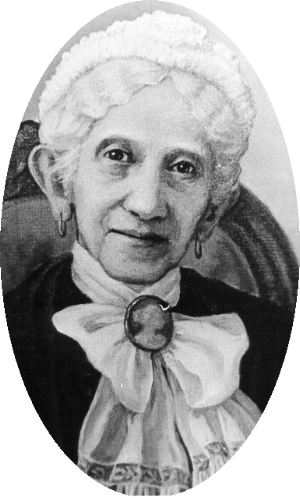
Historian James B. Sellers asserts that "Amelia Gayle Gorgas was, perhaps, the first woman to set the imprint of her personality on the growing University." Mrs. Gorgas served the University of Alabama as hospital matron, librarian, and post-mistress for twenty-five years until her retirement at the age of eighty in 1907. She was the first female librarian on the campus, and the Amelia Gayle Gorgas Library was the first academic building at the University named for a woman.
Amelia was born June 1, 1826, in Greensboro, Alabama. She was the third of six children born to John Gayle and his wife, the former Sarah Ann Haynsworth. Gayle was a lawyer who served in the Alabama Supreme Court, the Alabama Legislature, as the sixth governor of Alabama (1831 to 1834), and as a representative to the U.S. Congress.
After graduating with honors from Columbia Female Institute in Tennessee, Amelia travelled to Washington with her congressman father in 1847 and became acquainted with John C. Calhoun, Henry Clay, and President James K. Polk. On July 4, 1848, she was one of two women on the platform when the cornerstone was laid for the Washington monument.
In 1853, Amelia married Captain Josiah Gorgas, a native of Pennsylvania and graduate of West Point. The first of their six children was born in 1854, William Crawford Gorgas, who later won international acclaim for his work in conquering yellow fever in Cuba and the Panama Canal.
Josiah's military career took the Gorgas family to Maine, South Carolina, and Pennsylvania until he
resigned in 1861 to become Chief of Ordinance for the Confederate States Army. The family spent the war years in the Confederate capitol, Richmond, Virginia,
and returned to Alabama in 1866.
Several years later, Josiah accepted the position of vice-chancellor at the newly formed University of the South at
Sewanee, Tennessee, a post he held until 1878, when he was elected president of the University of Alabama.
Due to failing health, however, he resigned this
post in 1879 at which time the position of University librarian was created for him. At the same time, Amelia, then in her mid-fifties, was appointed hospital
matron, nursing sick students in their home, which is known today as the Gorgas House. 
After Josiah's death in 1883, Amelia assumed the duties of librarian and was also appointed postmistress in 1886. Of her varied duties, however, Amelia is best remembered as librarian, increasing the fledgling University collection from 6,000 to about 20,000 volumes.
In the 1894 Corolla, one student described the atmosphere of the library as follows:
"The library is open from 11 O'clock until 4 O'clock, during which time you can see a good many boys reading current periodicals.... Those desiring to read books usually draw them and carry them to their rooms, where they can keep them no longer than two weeks.... I hastily glanced at the latest North American Review, also Puck, and went over and took my seat by Mrs. Gorgas, the Librarian, for a few moments chat....I would consider my college course well spent had I gained nothing else outside of my association with her."
The 1896 Corolla was dedicated to Amelia, who was loved and respected by the students, with the following tribute:
"Conforming to the unanimous desire of the Alabama Cadet Corps, and thus, in a measure, expressing their filial love, the Corolla of 1896 is dedicated to Mrs. Amelia G. Gorgas, whose tender ministrations to the sick, motherly counsel to the wayward and erring, and words of encouragement and incentive to all, have made her the good angel of their college home."
In 1906, the Corolla was again dedicated to Amelia. Other honors included the presentation of the first silver loving cup ever awarded at the University and the presentation in 1907 of a retirement allowance for "splendid service" from the Carnegie Foundation.
After Mrs. Gorgas' death on January 3, 1913, a movement was begun to build a memorial, a library building, which was completed in 1925 (the present Carmichael Hall). When the new Library was completed in 1939, it too was named for Amelia Gayle Gorgas. Her portrait, which hangs on the Second Floor of the Library, was a memorial sponsored by alumni and presented in 1937. Amelia Gayle Gorgas was elected to the Alabama Women's Hall of Fame in 1977.
Bibliography
Dalrymple, Dolly. “Amelia Gorgas—A Portrait of a Lady.” Birmingham News, 29 November 1937, 10.
Curb, Randall, ed. Historic Hale County. Preservation Committee of Alabama Reunion, 1989.
Gorgas, Marie D. and Burton J. Hendrick. William Crawford: His Life and Work. Garden City, New York: Doubleday Page and Company, 1924.
Johnston, Mary Tabb and Elizabeth Johnston Lipscomb. Amelia Gayle Gorgas: a Biography. University, Alabama: University of Alabama Press, 1978.
“$100,000 Memorial to Mrs. A.R. Gorgas.” New York Times, 19 June 1916, 6.
Owen, Marie Bankhead, comp. Our State—Alabama. Birmingham: Birmingham Printing Company, 1927.
Vandiver, Frank F. “Josiah Gorgas and the Brierfield Iron Works.” The Alabama Review (January 1950): 6-21.
![]() Other Inductees
Other Inductees
![]() Alabama Women's Hall of Fame
Alabama Women's Hall of Fame